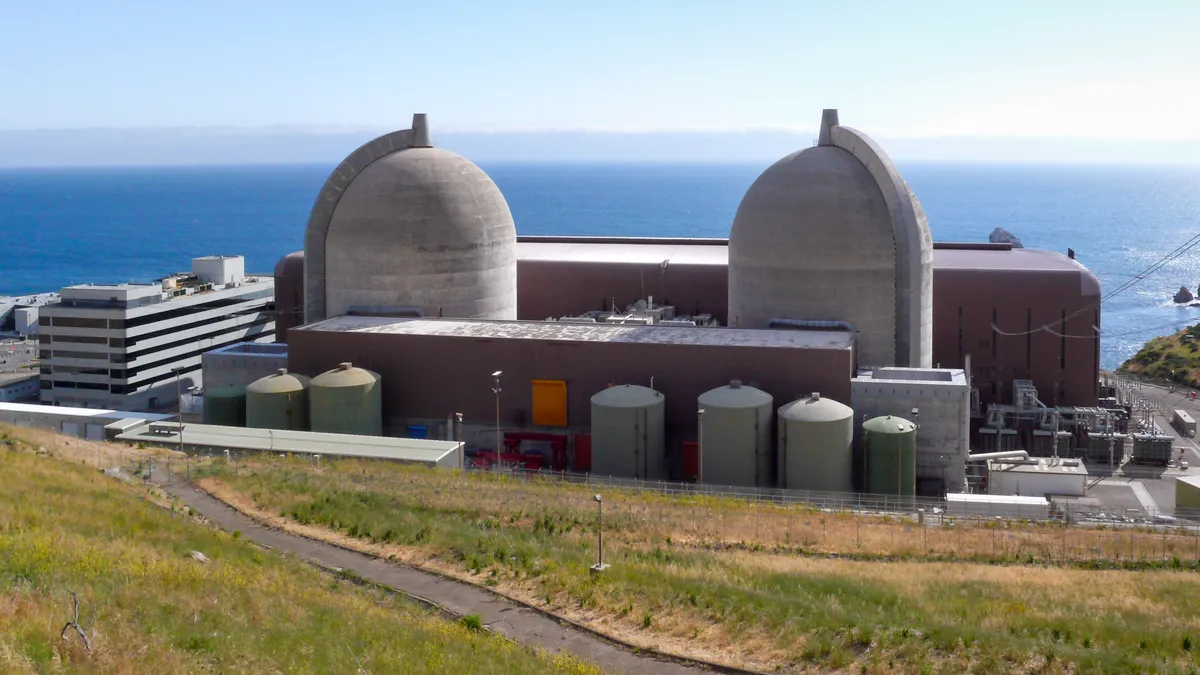Dive Brief:
- California policymakers and other stakeholders remain split on a proposal from Gov. Gavin Newsom, D, to extend the operations of the Diablo Canyon nuclear plant’s two units beyond their scheduled retirement in 2024 and 2025.
- The extension of the Diablo Canyon plant will provide California with substitute carbon-free energy in the event that the renewable resources that the state is banking on for reliability don’t come online in time, “particularly as they face headwinds such as supply chain constraints, inflation, and other kinds of uncertainty,” Karen Douglas, senior energy advisor to the governor, told lawmakers at a Thursday hearing. In 2022, there was a roughly 40% drop off between the resources state regulators expected would come online by the summer and what actually came online, according to Douglas.
- However, utilities and power providers in California have been actively procuring new resources to meet the state’s reliability requirements, Ed Smeloff, advisor with the Clean Power Campaign, said. “This sort of upsets the apple cart. Each of the 40 or so load-serving entities are actively trying to figure out how they’re going to meet the procurement responsibility… and now you’re imposing upon them this new uncertainty,” he said.
Dive Insight:
The Diablo Canyon plant, California’s last operating nuclear facility, produces roughly 8.5% of in-state generation. Regulators in 2018 approved a plan to shutter the plant’s two units in 2024 and 2025. But recent grid reliability challenges – including blackouts experienced by the state during a heatwave in 2020 – have prompted policymakers to question whether the plant’s lifespan should be extended.
California is facing a combination of factors that could threaten grid reliability, including the planned retirement of a suite of natural gas plants as well as electricity demand that is projected to rise faster than previously anticipated. Last year, the California Public Utilities Commission ordered power providers in the state to collectively procure 11.5 GW of new clean energy resources to meet this demand. However, regulators worry that supply chain constraints and other factors could delay the projects.
In August, Newsom unveiled a proposal to keep the two units of the plant online until 2029 and 2030, with the additional option of extending them through 2035. The proposal includes a $1.4 billion taxpayer-funded loan to Pacific Gas & Electric to relicense the plant.
State lawmakers held hearings Thursday and Friday to hear from the Newsom administration, PG&E and other stakeholders on the proposal.
When the California Energy Commission constructed its year-ahead supply stack outlook for the summer of 2022, it expected that around 4,000 MW of resources would be online and available by the summer, Douglas told lawmakers. However, closer to 2,500 MW of that actually materialized.
“So that is just under a 40% drop off between what we expected to come online to support load this summer, and what actually came online,” she said, adding that assuming similar delays in the future, the state will be quite a bit below its electricity reliability targets.
Newsom’s proposals would create the conditions for an extension of Diablo Canyon to be possible, Ana Matosantos, cabinet secretary with Newsom’s office, said.
“It does so in a way that is designed to maximize available federal funding for an extension, so that it can be… cost-effective for California taxpayers and ratepayers, and it also provides certainty to the community in terms of the decommissioning process,” Matosantos added.
If state policy were to change to extend the operations of Diablo Canyon, there are a number of necessary federal and state approvals that would be needed, Maureen Zawalick, vice president of decommissioning and technical services at PG&E, said at the Thursday hearing.
“There are also some critical near-term activities we would have to quickly undertake,” including funding, fuel purchasing and used fuel management, she added.
Ratepayer advocates, however, continue to have concerns about the proposal. Mark Toney, executive director of The Utility Reform Network, raised particular concerns that it would enrich PG&E shareholders at the expense of ratepayers and taxpayers, and exacerbate California’s energy affordability crisis by increasing customers’ monthly bills.
“This proposal is a nightmare for ratepayers, a nightmare for taxpayers, and it’s a dream come true for PG&E shareholders,” he said Thursday.
Ralph Cavanagh, energy program co-director with the Natural Resources Defense Council, also questioned why none of the state’s energy regulators had actually published a report recommending the extension of Diablo Canyon and comparing it with the cost and availability of alternatives. Normally in California, this comparison would involve conducting a competitive test, seeking proposals, and looking “for resources all over a gigantic Western grid that’s seven times the size of Texas … but we’re not doing any of that,” Cavanagh said.
“Instead, you are being asked in the final days of this session to declare a very expensive winner in a competition that your electricity regulators haven’t organized or even analyzed,” he said to lawmakers.















